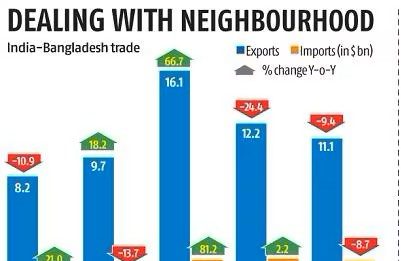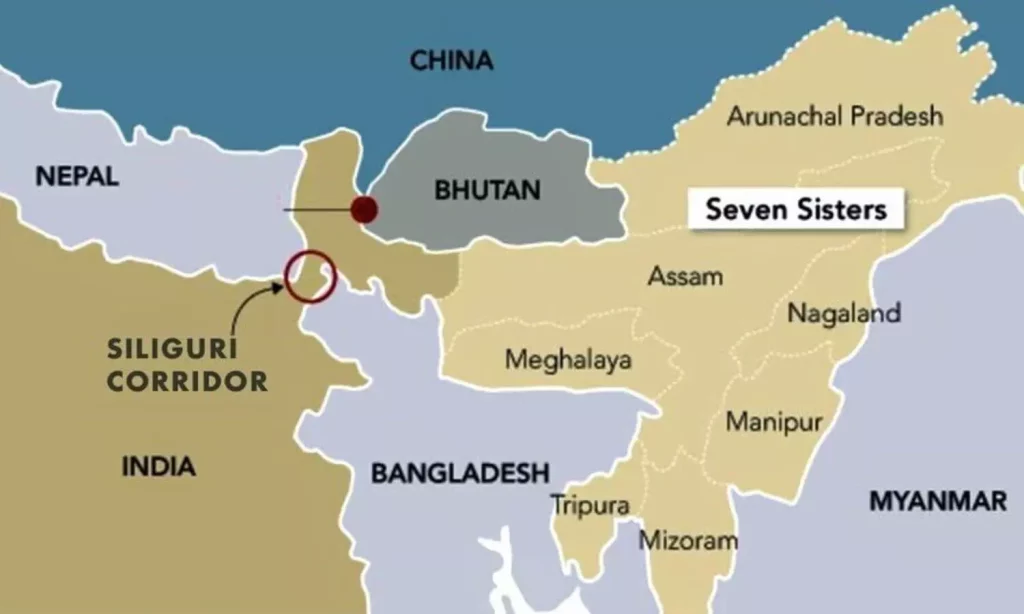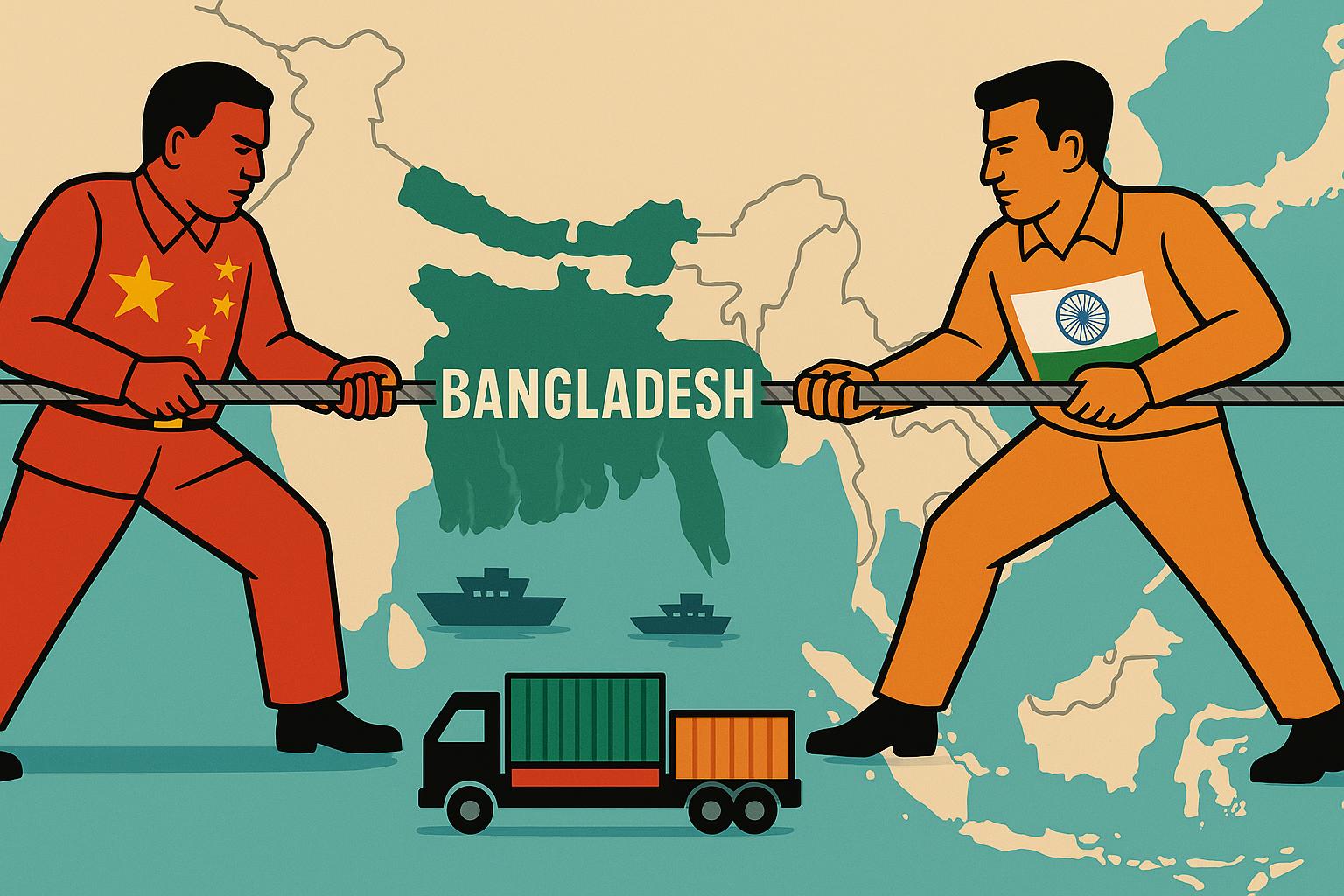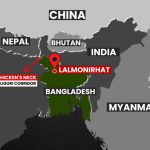India and Bangladesh share a robust trade relationship, with Bangladesh ranking among India’s top trading partners in South Asia. Bilateral trade exceeded $18 billion in recent years, with Bangladesh heavily reliant on Indian imports for essential goods and raw materials. However, recent months have seen a sharp escalation in trade restrictions, with India curbing imports of several Bangladeshi products and Bangladesh imposing barriers on Indian goods. These moves come amid shifting diplomatic alignments and growing geopolitical friction, underscoring the economic and strategic significance of their trade ties.
Nature and Reason for the Restrictions
India’s latest measures, announced in May 2025, restrict 42% of imports from Bangladesh—valued at $770 million—by limiting key products such as ready-made garments, processed foods, and plastic goods to entry only through the Kolkata and Nhava Sheva seaports. This effectively bans their import via land routes, historically vital for cross-border trade, especially with India’s northeastern states. The restrictions are a direct response to Bangladesh’s own trade barriers, including bans on Indian yarn, rice, and other products, as well as increased transit fees and tighter inspections. While some restrictions, such as those on onions, have been temporary and linked to domestic price controls, others reflect deeper structural shifts in trade policy.

Historical Precedents
Historically, India has occasionally imposed export bans or restrictions on essential commodities such as onions, sugar, and sometimes pulses, often in response to domestic shortages or price volatility within India. For Bangladesh, which relies heavily on Indian agricultural products due to geographical proximity and cost advantages, these bans have led to sudden price hikes and supply shortages, causing difficulties for consumers and businesses alike.
In many previous instances, these trade disruptions were temporary and resolved relatively quickly through diplomatic talks and cooperation between the two countries. Both sides recognized the mutual benefits of smooth trade and worked together to ease restrictions, ensuring supply chains resumed without long-term damage.
However, the current situation appears more complex and entrenched. Broader geopolitical factors—including shifting regional alliances, internal political dynamics, and concerns over border security—have made negotiations slower and more challenging. Additionally, India’s increasing focus on protecting its domestic industries and self-sufficiency under various economic policies means that trade restrictions may no longer be temporary fixes but part of a longer-term strategy.
This evolving context suggests that while past precedents offer hope for eventual resolution, the trade relationship between India and Bangladesh is facing new structural challenges that require deeper engagement and possibly new frameworks to ensure stability and mutual benefit.
Diplomatic and Strategic Angle
The trade restrictions imposed by India on Bangladesh go beyond simple economic measures and are deeply intertwined with broader geopolitical shifts in South Asia. Over recent years, Bangladesh has been gradually diversifying its diplomatic and economic relationships, notably strengthening ties with China. This pivot is seen by New Delhi as a strategic challenge, given China’s growing influence in the region through initiatives like the Belt and Road Initiative (BRI) and increased investments in infrastructure and manufacturing in Bangladesh. India’s trade restrictions can thus be interpreted as a form of economic pressure or retaliation, aimed at signaling displeasure with Bangladesh’s closer engagement with China and as a way to discourage what it perceives as Bangladesh drifting away from its traditional alignment with India.
Additionally, Bangladesh has imposed its own trade barriers against Indian goods, fueling a tit-for-tat dynamic that further complicates bilateral relations. The political landscape in Bangladesh has also shifted with the rise of an interim government viewed by India as less friendly or cooperative. Controversial statements from Bangladeshi officials regarding bilateral issues have added fuel to the fire, heightening diplomatic tensions. This deteriorating relationship creates openings for China to deepen its influence by positioning itself as a reliable partner for Bangladesh, both in trade and strategic cooperation. As Bangladesh seeks to diversify its trade and investment sources, Chinese involvement grows, potentially at India’s expense. The evolving diplomatic and strategic contest between India, Bangladesh, and China thus shapes the current trade restrictions, reflecting broader regional power dynamics rather than isolated economic disputes.
Impact on Bangladesh
The trade restrictions imposed by India are expected to create a ripple effect across multiple sectors of the Bangladeshi economy—disrupting exports, raising prices, straining small businesses, and affecting overall economic stability.
Economic Disruptions
Bangladesh’s ready-made garment (RMG) exports to India, valued at $618 million in 2024, have been severely impacted by recent land route restrictions. Exporters are now compelled to use seaports like Kolkata and Nhava Sheva, leading to increased shipping costs and extended delivery times. This disruption poses a major challenge to the industry’s just-in-time delivery model, risking delays that could result in missed deadlines and canceled orders—particularly for seasonal and fast-fashion items. Consequently, Indian retailers may seek alternative suppliers such as Vietnam or turn to domestic production, threatening Bangladesh’s market share and long-term position in the Indian garment market.
Inflation and Price Rise
India’s export restrictions on essential items like onions have already triggered sharp price increases in Bangladesh. As a daily staple, any disruption in onion supply leads to hoarding, black marketing, and rapid inflation. The impact could be even more severe if similar curbs are placed on other key commodities such as lentils, spices, or cooking oils, significantly straining household budgets—particularly for low-income families. Additionally, the shift from cost-effective land routes to more expensive sea transport has raised fuel and logistics costs, which are ultimately passed on to consumers, driving up the prices of everyday goods across the board.
Impact on SMEs and Local Industries
Trade restrictions between India and Bangladesh have had a significant impact on SMEs and local industries, especially in border towns like Benapole, Hili, and Burimari. These small businesses, which heavily depend on land-based trade with India, have faced sharp declines in revenue due to disrupted cross-border exchanges. Many SMEs rely on informal or semi-formal trade channels that are difficult to redirect through official ports, leading to business closures and layoffs. Additionally, job losses have extended to supporting sectors such as transportation, warehousing, packaging, and loading/unloading services, further reducing employment opportunities and income for local communities that depend on this vibrant cross-border economy.
Currency and Trade Balance Issues
The trade restrictions have exacerbated Bangladesh’s existing trade deficit with India, as reduced exports combined with continued imports widen the gap, putting additional strain on the country’s foreign exchange reserves. This imbalance creates pressure on the Bangladeshi Taka, which may depreciate due to higher import costs and lower export earnings. A weaker Taka can fuel inflation and increase the cost of debt repayments, further challenging the economy. As a result, Bangladesh may be forced to shift its import partners toward costlier or less reliable sources such as China, Thailand, or Malaysia for essential raw materials and food, leading to higher transaction costs and increased dependency on alternative markets.
Disruption in Industrial Inputs
Trade restrictions have disrupted the supply of essential raw materials to Bangladeshi industries, particularly in textiles and pharmaceuticals, which heavily rely on inputs like yarn, dyes, chemicals, and packaging from India. These shortages risk reducing production output and delaying order fulfillment. To compensate, domestic producers may have to source materials from more distant countries, leading to longer lead times and increased operational costs. Consequently, higher input costs undermine the price competitiveness of Bangladeshi exports in global markets, posing a significant challenge to the country’s long-term trade prospects.
Here is the summary in a tabular form:
| Impact Area | Details |
|---|---|
| Export Disruptions | – Garment exports to India ($618M) hit by loss of land routes. – Increased shipping costs and delays via sea ports. – Risk of losing market share to competitors. |
| Inflation and Price Rise | – Price hikes in staples like onions due to export bans. – Possible rise in prices of lentils, spices, and cooking oils. – Increased transport costs passed to consumers. |
| Impact on SMEs and Local Industries | – Border town businesses face revenue losses. – Disruption of informal trade routes. – Job losses in transport and warehousing sectors. |
| Currency and Trade Balance Issues | – Worsening trade deficit with India. – Depreciation pressure on Bangladeshi Taka. – Increased reliance on costlier alternative suppliers. |
| Disruption in Industrial Inputs | – Shortages of raw materials like yarn and chemicals. – Increased production costs for industries. – Reduced export competitiveness globally. |
Impact on India
While the trade restrictions may offer some immediate benefits to certain sectors, they also carry risks that could affect India’s long-term economic interests and regional influence.
Short-Term Gains
India’s trade restrictions on Bangladesh provide some immediate advantages, particularly for domestic industries and political considerations. By limiting cheaper Bangladeshi garment imports, Indian textile producers gain temporary relief, which may help boost their market share and revenues. Similarly, restrictions on agricultural products like onions help protect Indian farmers’ incomes by stabilizing domestic prices during shortages. Politically, these moves address local demands from industries and farming communities, potentially securing support in key electoral regions. Moreover, the curbs align with India’s broader “Make in India” initiative by encouraging domestic production of goods that were previously imported from Bangladesh. Finally, tightening trade controls can improve border monitoring, reducing smuggling and illegal trade activities.
However, these restrictions carry significant long-term risks that could undermine India’s strategic and economic interests in the region.
Long Term Risks
The strained trade ties risk damaging the historically friendly relationship between India and Bangladesh, affecting cooperation on critical issues such as water sharing, border security, and regional connectivity. This approach contradicts India’s “Neighbourhood First” policy, which aims to strengthen relations with South Asian neighbors, potentially eroding India’s credibility and influence in the region. Additionally, as Bangladesh looks to diversify its partnerships, China stands to gain increased economic and strategic footholds in Bangladesh, posing a challenge to India’s regional dominance. The economic fallout may also hit Indian border states like West Bengal, Assam, and Tripura, which rely heavily on cross-border trade for growth and employment. Lastly, these trade barriers threaten to weaken regional integration efforts under platforms like SAARC and BIMSTEC, slowing progress toward economic cooperation and connectivity in South Asia.
Also Read: China Aids Revival of WWII-Era Bangladeshi Airbase Near Siliguri
Strategic Importance of India’s Northeast
India’s northeastern states, including Tripura, Meghalaya, Assam, and others, have historically maintained strong economic and social ties with neighboring Bangladesh. Due to their geographic isolation from mainland India and limited connectivity, these states heavily rely on cross-border trade with Bangladesh for essential goods, consumer products, and raw materials. This trade supports local businesses, sustains markets, and helps keep prices stable. When trade restrictions are imposed, these states face shortages of goods, which can lead to inflation and reduced availability of everyday essentials. The economic disruptions have a direct impact on the livelihoods of local populations, many of whom depend on this bilateral trade for their income and access to affordable products.
Beyond economic consequences, the restrictions can create political tension within these northeastern states, where communities often have strong cultural and familial connections across the border. Local leaders and residents may express dissatisfaction with New Delhi’s policies, seeing them as harmful to regional development and integration. Prolonged trade curbs risk undermining the political stability of these areas, potentially fueling unrest or calls for greater autonomy.

Possible Future Scenarios
If the trade restrictions between India and Bangladesh persist, the consequences could significantly reshape the regional balance of power and economic ties. Bangladesh, feeling constrained by Indian trade barriers, may accelerate its efforts to strengthen economic and strategic partnerships with China and other alternative markets. This shift could deepen regional fragmentation by creating competing spheres of influence, reducing India’s traditional dominance in South Asia. Increased Chinese investment and infrastructure development in Bangladesh, combined with expanding trade links, might not only challenge India economically but also strategically, as Beijing gains a foothold closer to India’s borders. This scenario risks long-term weakening of the historically close India-Bangladesh relationship, making cooperation on broader issues such as security, water sharing, and regional connectivity more difficult.
On the other hand, if the trade restrictions are lifted, it could pave the way for a significant reset in bilateral relations. Both countries stand to benefit from restoring smooth trade flows, which would help revive border economies, improve regional integration, and rebuild trust. This opening could encourage the establishment of more resilient and transparent trade mechanisms that address past grievances while promoting fair competition and mutual benefit. Such a positive shift might also facilitate broader diplomatic dialogue, enabling cooperation on regional security and infrastructure projects. In this optimistic scenario, India and Bangladesh could reaffirm their partnership as key neighbors and collaborators, strengthening economic growth and stability in South Asia.
Conclusion
The recent trade restrictions between India and Bangladesh represent a critical juncture in their bilateral relationship, signaling shifts that extend far beyond simple economic concerns. These measures have exposed underlying political tensions and strategic competition, highlighting the fragility of ties that were once considered relatively stable and cooperative. The disruptions caused by these restrictions affect not only trade and industry but also the social fabric and political dynamics of border regions, underscoring how interconnected the two countries are.
Moving forward, it is clear that sustainable and mutually respectful trade policies are vital for maintaining regional stability. Both India and Bangladesh stand to gain significantly from a collaborative approach that balances national interests with the needs of local economies and communities. Without such cooperation, there is a risk that unresolved trade disputes could escalate into broader geopolitical rivalries, further complicating South Asia’s already complex landscape. Ultimately, fostering an environment of trust and openness in trade will be key to promoting economic growth, strengthening diplomatic relations, and ensuring peace and stability in the region for the long term.













